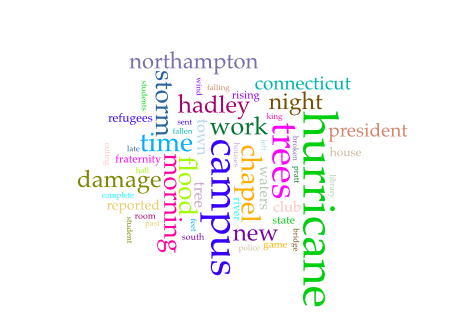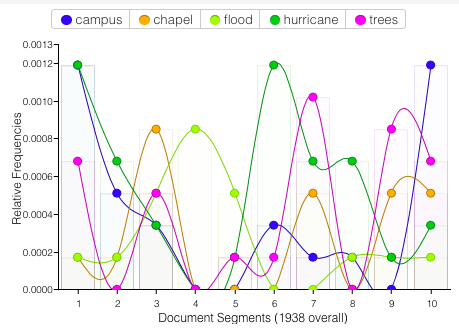An Analysis of Language
After searching through the collection of previous Amherst Student issues, I gathered all articles pertaining to the hurricane of 1938 into chronological order. Then, I used Voyant, a program that analyzes the texts and produces visual representations of patterns found in the language.
Here are the results that highlighted some interesting trends:


The average words per sentence was 23.6. Excluding “Amherst” and “college” from the list, the most five most frequently used words were: hurricane (32), trees (24), campus (23), chapel (16), and flood (16).
Looking at the word cloud, “hurricane” is unsurprisingly the most frequently used word. “Trees” is also notably frequent, unexpectedly appearing more often than “flood.” According to the articles written in the Amherst Student, it seemed that the majority of the damage sustained on campus was from trees being knocked down and damaging infrastructure/power lines. Nearby towns were hit much more heavily with flooding waters. Additionally, the Student gives considerable attention to the planting of new trees in the restoration process a few months after the hurricane occurred.
Surprisingly, the word “chapel” also makes an appearance on the list. Originally I had mistakenly believed that Johnson Chapel would be frequently mentioned because of its religious significance and tendencies to turn to religion during times of crisis or uncertainty. However, religion did not seem to be a popular topic in the issues I examined. Rather, the chapel became a place where the community could come together in the catastrophic time. Volunteers would gather here before setting out to clean the campus, turning the chapel into a “home base.” President King could also make announcements and address the entire community here. Even as we compare to the time period of the pandemic in which we are living in now, we can see the reoccurring theme of having an increased need for communication during catastrophes, as well as a strong leader who will unify the people during times of chaos. This explains why “President” and “King” appear in the word cloud as well.
The Student also gives extensive coverage on the conditions of neighboring towns, which explains the appearance of “Northampton” and “Hadley” in the word cloud. A lot of the reports focused on how these towns were impacted by the hurricane, as well as several residents’ accounts of their experiences in the disaster. Amherst also played a role in helping provide relief for victims whose homes were hit harder than the campus was.

The document was also broken into ten segments (in chronological order) to map the usage of these words over time. Looking at Figure 2, one can see some interesting trends about how language was used throughout the length of the disaster.
The use of “campus” is extremely high at the very beginning as well as very ends of the corpus (sections 1 & 10). “Hurricane” hits its peak in the middle, around section 6, while “flood” does so in section 4. “Trees” comes in around three different waves, as does “chapel,” though its subsequent two peaks never reach the height of frequency it did in the first wave. Chapel is used more frequently in the beginning likely because (and this ties into my earlier analysis with the word cloud) effective and clear delivery of information was needed early on in the hurricane relief process; the chapel served as the ideal gathering location for school-wide meetings to deliver the news.
Navigation:

You must be logged in to post a comment.